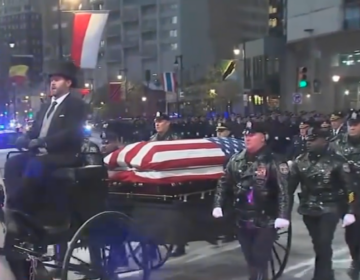Behind the scenes at the SPCA: Investigating animal cruelty
George Bengal of the Pennsylvania SPCA is like the Ed McMahon of animal rescues. There’s just one difference: When he comes to your door, he’s not bringing an oversized check and balloons.
“I’ve had cases where the people we’re investigating will say to me, ‘I know you, I’ve seen you on TV,” said Bengal. “And to that I say: ‘And now you’re going to be on TV with me, but it’s not for a good reason.”
As the director of humane law enforcement for the Pennsylvania SPCA, Bengal has seen everything from dog-fighting, as seen in the recent Germantown case, to pet hoarding. He’s also a retired Philadelphia police officer.
With 12 humane officers on the team, the group can have a workload of 30 to 50 cases at one time. They also have the daunting task of enforcing the animal cruelty laws for 16 counties.
“People often think that we’re funded by the state because we’re enforcing state laws, but that’s not the case,” said Bengal.
His team is constantly following-up on calls and investigating animal cruelty and abuse.
“We have a twenty-four-seven hotline,” said Bengal, “calls come in everyday and we look into each one. Every time I think I’ve seen the worst case, another one will top it,” said Bengal.
A look into the world of animal fighting
Bengal says he has seen horrific scenes of animal fighting. The fights, which are motivated by money, involve high-end betting.
“In one case, my team found half a million dollars in cash at a home,” said Bengal. “It’s a blood sport. These animals are trained to fight, even to the death.”
He says the fights attract large crowds and he’s seen over 100 people in one house. Spectators can be charged just for watching.
“In many cases, women will be cooking and actually selling food upstairs in the kitchen, while downstairs the men are watching the fighting,” said Bengal.
He says the animals are trained to fight from a young age. Owners may start out playing tug-of-war with the dog as a puppy using a towel or rope. Eventually, they will start training with weight pulls for a sled, which are legal.
“They train them like it’s a fun game,” explained Bengal. “Eventually, they’ll put heavy chains on their necks to strengthen them, pump them full of steroids and have them run on treadmills. Animal fighting is like a boxing match.”
The fights are so serious that the owners will even pay for a cutman to treat physical damage during the fight.
“These guys will go so far as to put a sedative or poison on their fur, so that when the other dog bites, he’ll get weak and sick,” explained Bengal. “With cock fighting, they will implant knives or gaffs on the animals claws.”
When asked if the owners ever feel remorse for their actions, Bengal says they only think of the animals as valuable property.
“They’re mad when we take their animals because some of them are worth thousands of dollars,” said Bengal.
“Some of these dogs are grand champion fighters, and their pups alone can be worth $20,000 to $50,000.”
Dangerous hoarder homes
Can you imagine 110 Chihuahua’s living in one home? Bengal can. He says that typically, animal hoarding goes hand-in-hand with other types of hoarding, which can mean a dangerous situation for both animals and humans alike.
“These are some of the most tragic cases,” said Bengal. “These people have serious issues. They’ve lost their ability to know what’s right and wrong. They don’t having running water, they don’t get things fixed.”
He says for many hoarder cases his team must wear protective gear and breathing masks due to mass amounts of feces and garbage.
“We’ll find dead animals inside these houses,” said Bengal. “One woman actually asked if she could take pictures of the dead ones before we took them out, she was that mentally attached.”
He says homicide cases for humans mean a felony or a death sentence, but when an animal is killed, it may only mean minimal jail time or a fine.
“When we go to a location, it’s a lot like a narcotics investigation. We get forensic evidence and autopsy results to determine the cause of death,” said Bengal. “We treat these cases as if it were a regular homicide.”
The SPCA works with the Licenses and Inspections (L&I) department to get people out of these conditions and find them psychiatric help. In some cases the properties may be deemed unlivable and are condemned.
“We try to do as much as we can,” said Bengal. “You have to stay professional at all times. Our job is a combination of a cop, social worker and educator.”
Healing hands at the SPCA
Wendy Marano, spokeswoman for the Pennsylvania SPCA, says the group has a “no kill” philosophy.
“No animal comes here with a clock ticking,” said Marano. “We work hard to get them better, we want to give them a second chance.”
She says the SPCA team works to rehabilitate abused animals so that they may one day enter into an adoptive home.
WHYY is your source for fact-based, in-depth journalism and information. As a nonprofit organization, we rely on financial support from readers like you. Please give today.




